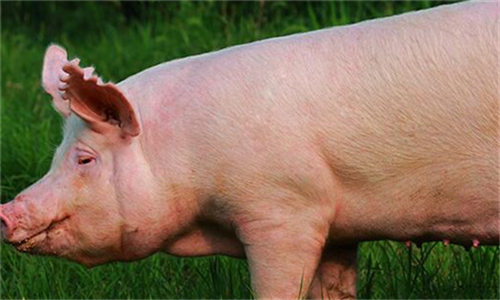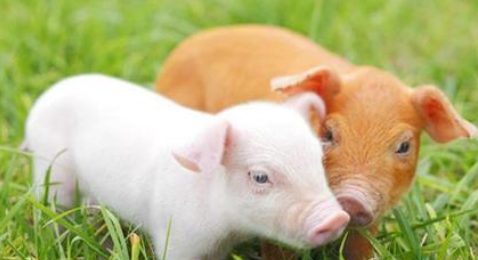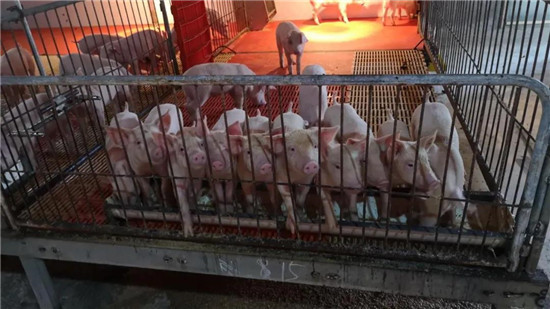Pigs are always inexplicably sick, are they poisoned by the following?
Pigs are always inexplicably sick, we should think about whether they have been poisoned or not. Have you met the standards for the problems that should be paid attention to in the management of pig farms?
Mycotoxin poisoning
Symptoms: reduced feed intake, reduced feed utilization, diarrhea, disorder of reproductive cycle of sows, abortion, false estrus, pseudopregnancy, vulvovaginitis, prolapse and nipple swelling, nipple scab necrosis, no milk in sows.
Lesions: anemia, jaundice, hemorrhagic diarrhea, liver yellowing and fibrosis or even hardening, gastric ulcer, pulmonary edema and so on.
Mycotoxin can pollute feed raw materials, means of transport, feeding tools and so on, and the symptoms are not clear after poisoning, poisoned pigs only show very slight abnormal behavior, so it is difficult to diagnose. Large silos and lines require particular attention, as the risk of mycotoxin contamination is high. Mildew can produce poison in a warm and humid environment, and if silos and lines are not cleaned regularly, toxins can easily accumulate in these places. Lack of protein, selenium and vitamins in diet is the susceptible factor of mycotoxin poisoning, and mildew in feed is the root cause of this kind of poisoning.
In recent years, ergot toxins have been particularly prominent, and if crops are found to have ergot during harvest, they can enter feed and bedding. Some large feed companies will inspect them during harvest and storage or some growers will inspect them during harvest. If these ergot are eaten by pigs, dry gangrene and scabs may occur at the ends of the pig's body, such as ears, tails, hooves and so on.
Corn gibberellone poisoning is also a common mycotoxin poisoning, which is similar to estrogen in structure and is difficult to identify in pregnant sows. There are symptoms of pudendal swelling, eight-legged legs and muscular dysplasia in newborn piglets, which are obvious symptoms of zearalenone poisoning. For sows, zearalenone can cause uterine and rectal prolapse after delivery. And corn gibberellone poisoning is also the main cause of prolapse of anus in growing pigs.
Large doses of vomiting toxins can make pigs sick within 10 minutes of eating (vomiting), while small doses will reduce the appetite of pigs. When pigs show anorexia, it is likely to be mycotoxin infection.
Measures: selection of high-quality feed raw materials, or replacement of feed is the only effective measure; preventive measures can use high-quality mold inhibitors (or mildew remover)
II. Poisoning by feed additives or drugs
Poisoning by benzene arsenic acid compounds (arsanilic acid and other arsenic preparations)
Symptoms: after-drive paralysis after ataxia, quadriplegia, no obvious anatomical lesions.
Measures: remove arsenic preparations from feed and drinking water as soon as possible.
Sulfonamides poisoning
Symptoms: nephropathy and uremia
Cause: excessive content in feed, excessive dosage or insufficient drinking water can cause poisoning.
Measures: stop feeding medicated feed, or add baking soda at the same time to increase the supply of drinking water.
Poisoning by conventional drugs or vaccines
Reason: the drug itself has been strictly tested before approval and has a high level of safety. It is the improper use of drugs and vaccines, such as overdose or improper preservation, that often lead to animal poisoning.
Measures: follow the doctor's advice, pay attention to the rational use of drugs and vaccines, stagger the action time of drugs.
III. Salt poisoning
Symptoms: initial poor appetite, mental depression, mucosal flush, increased thirst, constipation or dysentery, post-vomiting, a lot of salivation, foaming at the mouth, limb spasm, muscle tremor, dyspnea, back and forth, hearing and vision impairment, no response to stimulation; seriously ill pigs have paroxysmal spasms, head and neck raised in dog sitting position, obvious neurological symptoms on the head. In the later stage, the pig showed ankylosis, lying on one side, swimming-like convulsions in its limbs, and died on 1-2 days. Chronic salt poisoning often breaks out after lifting water restrictions and binge drinking, with symptoms such as constipation, thirst and skin itching.
Cause: salt poisoning or dehydration is caused by pigs not drinking enough water, which may be due to insufficient water supply or high salt content in the feed. Liquid feeding requires particular attention because some ingredients may contain more salt under unknown circumstances. In addition, there is no separate waterline, and if you encounter a high temperature, it is likely to cause meningitis-like symptoms, because it will affect the central nervous system. In the case of salt poisoning, rehydration should be carried out slowly, if the rehydration rate is too fast, it may lead to more serious symptoms and even death.
Measures: feed the poisoned pigs with paste or drink a small amount of water for many times. Intravenous injection of 10% calcium gluconate 60ml 100ml, you can also use 1% copper sulfate 50ml 100ml oral vomiting, take sugar 150g 200g.

IV. Toxic gas poisoning
Ammonia gas
Symptoms: excessive tears, shallow breathing, runny nose.
Reason: piggery manure decomposes on solid ground and is poorly ventilated.
Hydrogen sulfide
Symptoms: local inflammation of moist mucous membranes of the eyes and respiratory tract, severe pulmonary edema.
Cause: poor ventilation around the liquid cesspool.
Carbon monoxide
Symptoms: non-contagious miscarriage of sows or death of piglets giving birth.
Cause: poor ventilation in the delivery room where the fire was made.
Coal tar
Symptoms: acute and chronic liver injury, accompanied by anthrax, dysphagia and anemia, even leading to death.
Reason: some coal tar extracts such as phenol and cresol are widely found in paints and disinfectants, which can cause liver damage and even death after being eaten by pigs.
Measures: under the premise of keeping the appropriate temperature of the pig house and doing a good job of disinfection and purification measures, increase ventilation.
5. Pesticide poisoning
Cause: organophosphorus, carbamates and chlorinated hydrocarbon pesticides are most likely to cause pig poisoning. The main reasons are that pesticides are accidentally mixed into feed, scattered in pig pens, and overdosed or licked when spraying or spraying pesticides.
Organophosphorus and carbamate poisoning
Symptoms: salivation, defecation, vomiting, unstable gait, dyspnea, muscle tremor. Lesions: no characteristic lesions, usually a large amount of fluid in the respiratory tract and pulmonary edema.
Measures: 0.5 mg / kg body weight dose of atropine sulfate intravenous injection, severe can be combined with oral activated carbon.
Poisoning by chlorinated hydrocarbon insecticides
Symptoms: hyperexcitement and tonic clonic seizures. Pathological changes: only mechanical injury.
Measures: there is no specific medicine, but long-acting barbiturates can be used to sedate pigs. (auxiliary measures: if you rinse with warm soapy water through skin contact, if ingested by mouth, you can use the suspension of activated carbon and water, avoid using oil laxatives, and in serious cases, infuse glucose and infusion. )
VI. Mineral poisoning
Copper poisoning
Symptoms: jaundice, anemia, hemoglobinuria and glomerulonephritis.
Cause: the normal dietary requirement is 5-6 mg / kg, and the maximum tolerance is 250 mg / kg.
Iron poisoning
Symptoms: decreased food intake and weight gain, accompanied by rickets, cardiovascular shock if iron dextran poisoning, death within a few hours, and pigmentation at the injection site, liver and kidney.
Reason: the normal dietary requirement is 40,150 mg / kg, which is excessive.
Selenium poisoning
Symptoms: anorexia, hair removal, hoof shell cracking from the hoof crown groove, liver and kidney tissue degeneration; sows may show prolonged pregnancy, stillbirth and weak birth.
Reason: the normal requirement in the diet is 0.1-0.3 mg / kg, which is excessive.
Measures: adjust the mineral content in the diet or temporarily stop feeding this kind of feed.
7. Rodenticide
Anticoagulant rodenticide
Symptoms: lameness, lethargy, deep cedar oil-colored feces. Lesions: hematoma, joint swelling, intermuscular hemorrhage, anemia, black stool.
Measures: inject vitamin K.
Strychnine
Symptoms: severe compulsive convulsions, sensitive to external stimuli, and can die within 1 hour. Lesion: there is no obvious lesion, and the content of strychnine in stomach content can be detected.
Measures: long-acting barbiturate and other muscle relaxants to control spasms.
Once poisoning occurs, emergency termination of pig feeding or exposure to toxic substances is the first measure, symptomatic treatment can reduce losses, and standardizing breeding management and avoiding exposure of pigs to substances that may cause poisoning is the best and most effective way.
- Prev

Pig autumn respiratory and digestive tract diseases, teach you a trick to solve!
Pig autumn respiratory and digestive tract diseases, teach you a trick to solve!
- Next

More than 100 catties pig diarrhea what medicine to eat quickly, can you prevent it in advance?
More than 100 catties pig diarrhea what medicine to eat quickly, can you prevent it in advance?
Related
- On the eggshell is a badge full of pride. British Poultry Egg Market and Consumer observation
- British study: 72% of Britons are willing to buy native eggs raised by insects
- Guidelines for friendly egg production revised the increase of space in chicken sheds can not be forced to change feathers and lay eggs.
- Risk of delay in customs clearance Australia suspends lobster exports to China
- Pig semen-the Vector of virus Transmission (4)
- Pig semen-the Vector of virus Transmission (3)
- Five common causes of difficult control of classical swine fever in clinic and their countermeasures
- Foot-and-mouth disease is the most effective way to prevent it!
- PED is the number one killer of piglets and has to be guarded against in autumn and winter.
- What is "yellow fat pig"? Have you ever heard the pig collector talk about "yellow fat pig"?

